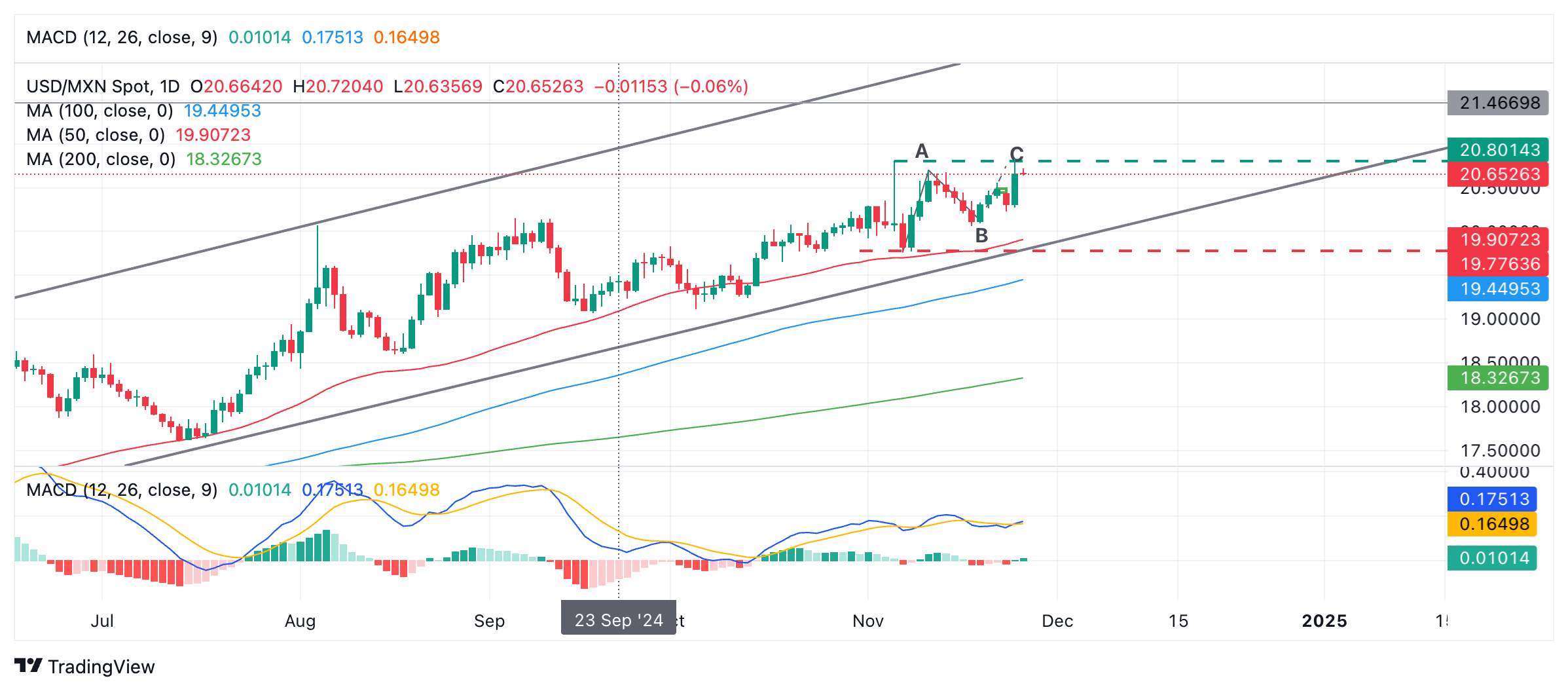- The Mexican Peso trades lower on Wednesday, but an escalation in rhetoric between US and Mexican leaders poses risks.
- Mexico’s President Sheinbaum reads out a letter on television warning Trump she’ll retaliate with tit-for-tat tariffs if he starts.
- Technically, USD/MXN remains at the top of a mini range as it consolidates within a broader uptrend.
The Mexican Peso (MXN) trades lower Wednesday after closing on average over 1.5% lower on Tuesday. Markets remain tense as the rhetoric between the United States (US) and Mexico leaders ramps up.
The previous day’s decline was caused by President-elect Donald Trump’s threat to tear up the US, Mexico and Canada free trade agreement (USMCA), and whack a 25% tariff on imports from both countries, unless they tightened their borders with the US and put an end to illegal immigration and narcotics trafficking. This led to a broad depreciation of the MXN and the CAD on fears that tariffs would result in lower exports and reduced demand for the FX to purchase them.
Mexican Peso weakens on escalating trade rhetoric
The Mexican Peso continued to see weakness after the President of Mexico, Claudia Sheinbaum, responded to Trump’s tariff threat during one of her regular televised press conferences on Tuesday. Sheinbaum read from an overhead projector passage from a letter she had written in response to Trump’s tariff threat.
“One tariff would lead to another in response,” said Sheinbaum, inferring that if the US raised levies on Mexican goods entering America, Mexico would do the same on US goods entering Mexico, adding that a trade war would achieve nothing more than “place at risk common businesses” in both country’s economies.
Sheinbaum highlighted Mexico’s existing willingness to cooperate with the US on border issues. She said illegal immigration into the US from Mexico had fallen by 75% from December 2023 to November 2024, according to US border patrol figures.
Mexico had always been willing to work with the US on reducing the traffic of Fentanyl across the border. Still, she added that the problem of drug abuse was the US “public health and consumption” problem, not a Mexican problem.
The Mexican President’s pugnacious response raised the spectre of a tariff war between the two countries that would significantly raise prices for US citizens, especially in the automotive spare parts sector of the economy.
Such a war would almost certainly increase inflation in the US, especially if it included Canada too, according to economists. This would lead the Federal Reserve (Fed) to maintain interest rates at elevated levels, which, in turn, would likely strengthen the US Dollar since higher interest rates tend to attract more foreign capital inflows.
Technical Analysis: USD/MXN tests the ceiling of mini range
USD/MXN remains at elevated levels above 20.50 on Wednesday, trading close to the top of the mini range (green dashed line on the chart below) formed during November.
The final C wave of a Measured Move pattern that has unfolded within the confines of the mini range now looks complete. Resembling zig-zags, such patterns normally exhibit a symmetry between waves A and C, which are usually of a similar length. This is currently the case with the example of USD/MXN.
USD/MXN Daily Chart
USD/MXN is probably range-bound in the short term as it oscillates within this mini range. However, it is still in an uptrend within a rising channel in the medium and long term.
It would require a decisive break above the top of the range at 20.80 to signal the start of a more bullish short-term trend in line with longer-term up cycles.
In the absence of such a breakout, the pair is likely to continue to oscillate within the parameters of its range, with the next move probably back down towards the range floor in the 19.70s (red dashed line).
A decisive breakout higher would be one accompanied by a long green candle that pierced and rose well above the range highs before then closing near its highs, or three green candles in a row that broke above the level.
Mexican Peso FAQs
The Mexican Peso (MXN) is the most traded currency among its Latin American peers. Its value is broadly determined by the performance of the Mexican economy, the country’s central bank’s policy, the amount of foreign investment in the country and even the levels of remittances sent by Mexicans who live abroad, particularly in the United States. Geopolitical trends can also move MXN: for example, the process of nearshoring – or the decision by some firms to relocate manufacturing capacity and supply chains closer to their home countries – is also seen as a catalyst for the Mexican currency as the country is considered a key manufacturing hub in the American continent. Another catalyst for MXN is Oil prices as Mexico is a key exporter of the commodity.
The main objective of Mexico’s central bank, also known as Banxico, is to maintain inflation at low and stable levels (at or close to its target of 3%, the midpoint in a tolerance band of between 2% and 4%). To this end, the bank sets an appropriate level of interest rates. When inflation is too high, Banxico will attempt to tame it by raising interest rates, making it more expensive for households and businesses to borrow money, thus cooling demand and the overall economy. Higher interest rates are generally positive for the Mexican Peso (MXN) as they lead to higher yields, making the country a more attractive place for investors. On the contrary, lower interest rates tend to weaken MXN.
Macroeconomic data releases are key to assess the state of the economy and can have an impact on the Mexican Peso (MXN) valuation. A strong Mexican economy, based on high economic growth, low unemployment and high confidence is good for MXN. Not only does it attract more foreign investment but it may encourage the Bank of Mexico (Banxico) to increase interest rates, particularly if this strength comes together with elevated inflation. However, if economic data is weak, MXN is likely to depreciate.
As an emerging-market currency, the Mexican Peso (MXN) tends to strive during risk-on periods, or when investors perceive that broader market risks are low and thus are eager to engage with investments that carry a higher risk. Conversely, MXN tends to weaken at times of market turbulence or economic uncertainty as investors tend to sell higher-risk assets and flee to the more-stable safe havens.
Information on these pages contains forward-looking statements that involve risks and uncertainties. Markets and instruments profiled on this page are for informational purposes only and should not in any way come across as a recommendation to buy or sell in these assets. You should do your own thorough research before making any investment decisions. FXStreet does not in any way guarantee that this information is free from mistakes, errors, or material misstatements. It also does not guarantee that this information is of a timely nature. Investing in Open Markets involves a great deal of risk, including the loss of all or a portion of your investment, as well as emotional distress. All risks, losses and costs associated with investing, including total loss of principal, are your responsibility. The views and opinions expressed in this article are those of the authors and do not necessarily reflect the official policy or position of FXStreet nor its advertisers. The author will not be held responsible for information that is found at the end of links posted on this page.
If not otherwise explicitly mentioned in the body of the article, at the time of writing, the author has no position in any stock mentioned in this article and no business relationship with any company mentioned. The author has not received compensation for writing this article, other than from FXStreet.
FXStreet and the author do not provide personalized recommendations. The author makes no representations as to the accuracy, completeness, or suitability of this information. FXStreet and the author will not be liable for any errors, omissions or any losses, injuries or damages arising from this information and its display or use. Errors and omissions excepted.
The author and FXStreet are not registered investment advisors and nothing in this article is intended to be investment advice.
Recommended content
Editors’ Picks

Gold price sits at fresh record high above $3,070 amid Trump's tariff plans
Gold price sits at fresh all-time peak above $3,070 early Friday as escalating global trade tensions, the uncertainty over Trump's reciprocal tariffs, and the risk-off mood continue to drive safe-haven flows. Bets that the Fed will resume its rate-cutting cycle soon lend additional support to the bullion.

USD/JPY stays weak below 151.00 after hot Tokyo CPI; US PCE awaited
USD/JPY keeps the selling pressure intact below 151.00 in late Asian trading on Friday. Hot Tokyo CPI figures and BoJ's March Summary of Opinions ramp up BoJ rate hike bets, supporting the Japanese Yen. Meanwhile, tariff jitters undermine the US Dollat, bolstering the haven demand for the Yen. US PCE eyed.

AUD/USD drops below 0.6300 amid trade war fears
AUD/USD drops back below 0.6300 in Friday's Asian trading, undermined by broad risk-aversion due to US President Trump's latest auto tariffs announcements. Traders now look to the US PCE Price Index for some meaningful impetus. Hopes for more stimulus from China could cap the Aussie's decline.

Top 3 crypto gainers today: SUI,TONCOIN, Pi Network price predictions
SUI, Toncoin, and Pi Network have emerged as the top-performing assets among the top 20 ranked cryptocurrencies on Thursday. These altcoins saw impressive gains driven by fundamental developments, institutional interest, and growing community activity.

US: Trump's 'Liberation day' – What to expect?
Trump has so far enacted tariff changes that have lifted the trade-weighted average tariff rate on all US imports by around 5.5-6.0%-points. While re-rerouting of trade will decrease the effectiveness of tariffs over time, the current level is already close to the highest since the second world war.

The Best brokers to trade EUR/USD
SPONSORED Discover the top brokers for trading EUR/USD in 2025. Our list features brokers with competitive spreads, fast execution, and powerful platforms. Whether you're a beginner or an expert, find the right partner to navigate the dynamic Forex market.
